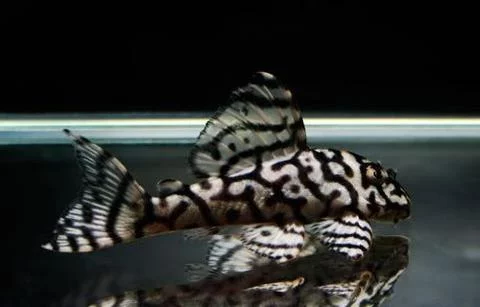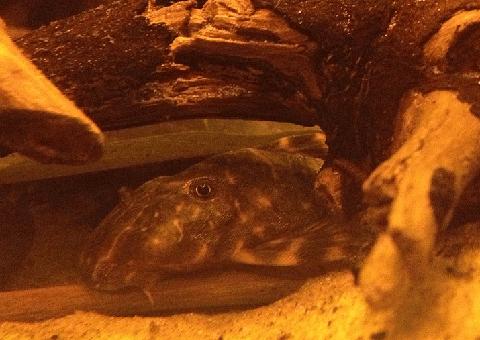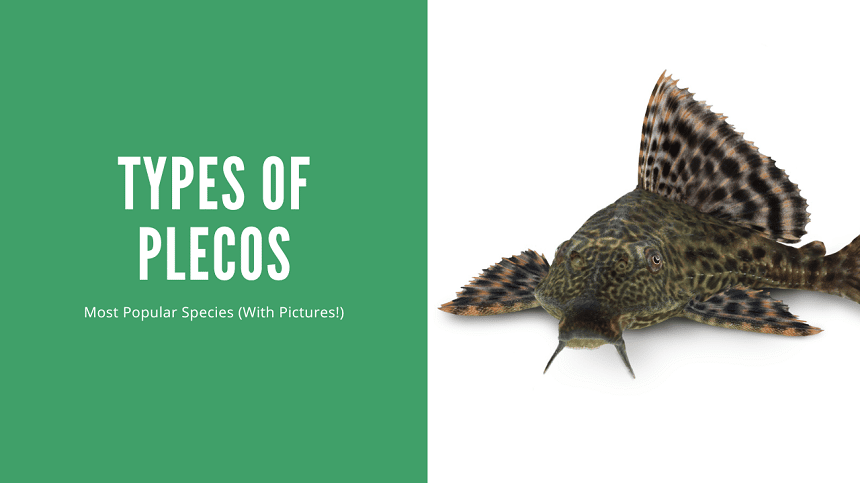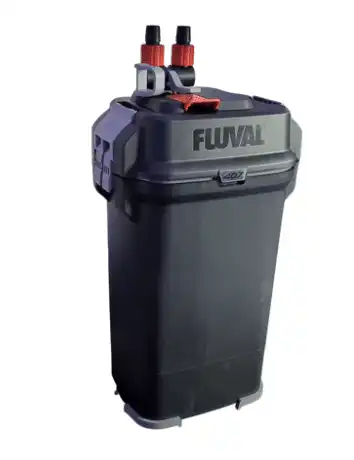Thank you for visiting! By the way… any links on this page that lead to products on Amazon and other stores/partners are affiliate links Aquarium Store Depot earns a commission if you make a purchase.
Plecos are some of the most unusual freshwater aquarium fish in the hobby. These armored catfish make long-lived pets and can really help to keep algae in check. There are so many types of pleco fish out there that choosing the right species for your tank can be tough though. If you’re not sure which pleco to buy, this article is just for you!
Read along to learn more about 15 amazing types of plecos. You’ll also learn the basics of how to keep and care for this fascinating fish along the way.
So let’s dive straight in!
Key Takeaways
- Plecos are suckermouth catfish that are known for feeding off algae in the aquarium
- They can range in my sizes from a few inches to over a foot long!
- They are generally peaceful fish and most fish won’t bother them as long as they don’t primarily swim at the bottom of the tank
What Are They?
Plecos are armored catfish from the Loricariidae family. The word pleco is short for plecostomus, which is actually the name of just one well-known fish from this group. Plecos range in size from small fish of about 3 inches, right up to monster fish that can grow over two feet!
Plecos are suckermouth catfish, and they spend their time on the bottom, feeding on algae and organisms that grow on rocks and driftwood. These fish are often found in fast-flowing rivers where they hang out under rocks and on fallen trees and other debris.
They are nocturnal fish, which means they are most active during the night. Many plecos make great cleaner fish because they keep your aquarium glass and hardscape free of algae. That doesn’t mean they don’t need to be fed and cared for, of course. Plecos are long-lived fish, that can make wonderful pets for over ten years.
What’s With The Numbers?
You may have noticed that most of the plecos sold at pet stores or online have a code name, starting with ‘L’. This system of naming plecos was developed way back in the 1980s when more and more different types of plecos were being introduced into the aquarium trade.
The number system makes it easier to identify exactly which species you have because there are so many different types of plecos and they can look pretty similar. In case you were wondering, the ‘L’ stands for Locariidae, which is the world’s largest family of catfishes.
Top 15 Types
With over 600 species of catfish in the Locariidae family, the variety of species in the aquarium trade can be pretty overwhelming! Here are 15 great options to make your decision a little easier. We have a YouTube video from our official channel just for you. Our blog post covers more details, so be sure to check out both. If you like our content, be sure to subscribe.
Take note of the following important information when choosing your favorite pleco species:
- Common Names
- L-Number
- Scientific Name
- Origin
- Adult Size
- Minimum Tank Size
- Care Level
- Temperament
- pH
- Temperature
1. Bristlenose Plecostomus
The Bristlenose Pleco is a smaller Pleco that does a great job of eating algae. Peaceful and gets along with most fish
- Common Names: Bushynose pleco, bristlenose pleco, Bristlenose catfish
- L-Number: Ancistrus sp.3
- Scientific Name: Ancistrus cirrhosus
- Origin: Argentina
- Adult Size: 3.5 – 5 inches
- Minimum Tank Size: 20 gallons
- Care Level: Easy
- Temperament: Peaceful
- pH: 5.5-7.5
- Temperature: 70-79 °F
Bristlenose plecos are one of the most popular pleco species in the hobby. The male bristlenose pleco grows interesting tentacles on his snout, which explains their common name. These peaceful plecos do great in a community tank, but it’s best to keep just one because they can be territorial with their own species.
These catfish are mostly vegetarian, so they should be fed algae wafers containing spirulina and supplemented with vegetables like zucchini and cucumber. Bristlenose plecos love to graze on wood, so make sure to provide plenty of driftwood at the bottom of the tank.
2. Zebra Plecostomus

- Common Names: Zebra pleco
- L-Number: L046
- Scientific Name: Hypancistrus zebra
- Origin: Brazil
- Adult Size: 3.2 inches
- Minimum Tank Size: 15 gallons
- Care Level: Moderate-advanced
- Temperament: Peaceful
- pH: 6-7.5
- Temperature: 79-86°F
The zebra pleco is an awesome little catfish with bold black and white stripes, just like its namesake. It is one of the smallest pleco species and can be housed in a tank as small as 15 gallons.
Zebra plecos are a good choice for dedicated fish keepers looking to set up a single-species tank. These fish need a combination of high oxygen and high water flow to really thrive. This kind of setup is pretty easy to achieve with an airstone, a small powerhead, and an aquarium heater.
3. Sailfin Plecostomus
- Common Names: Albino marble sailfin pleco, sailfin pleco
- L-Number: L165
- Scientific Name: Pterygoplichthys gibbiceps
- Origin: Peru
- Adult Size: 18 inches
- Minimum Tank Size: 125 gallons
- Care Level: Easy
- Temperament: Peaceful
- pH: 6.5-7.4
- Temperature: 74-79 °F
The sailfin pleco (video source) is easy to care for but requires a very large aquarium. These algae eaters can be identified by the prominent dorsal fin which looks like a huge sail.
Sailfin plecos are often sold at just a few inches but beware, they can grow to be well over a foot in length! These fish also require strong filtration because they generate a lot of waste.
4. Trinidad Plecostomus

- Common Names: Trinidad Pleco, Common Pleco
- L-Number: /
- Scientific Name: Hypostomus punctatus
- Origin: Brazil
- Adult Size: 12 inches
- Minimum Tank Size: 70 gallons
- Care Level: Easy
- Temperament: Peaceful
- pH: 5-8.2
- Temperature: 72-84 °F
The Trinidad pleco is very similar to the common pleco (Hypostomus plecostomus) and is often sold by that name. It is a large spotted pleco species that can be kept with smaller fish in a community tank but should not be kept with other Trinidad plecos.
This is a good algae eater for larger tanks but their diet should be supplemented with algae wafers to keep up with their voracious appetite.
5. Spotted Sailfin Plecostomus
- Common Names: Gold spot common pleco
- L-Number: L-001
- Scientific Name: Pterygoplichthys joselimaianus
- Origin: Brazil
- Adult Size: 12 inches
- Minimum Tank Size: 70 gallons
- Care Level: Easy
- Temperament: Peaceful
- pH: 6.5-7.4
- Temperature: 74-79°F
The spotted sailfin pleco is a great fish for larger community tanks. These fish boast a huge dorsal fin, just like the regular sailfin pleco, although they do not grow quite as large. Spotted sailfin plecos are also more boldly marked, with golden spots.
Spotted sailfin plecos are peaceful fish that do a great job of cleaning algae in the aquarium. Like the other pleco fish species, they prefer a tank with plenty of rocks and driftwood to graze on.
6. Peppermint Plecostomus
- Common Names: Peppermint pleco
- L-Number: L-31
- Scientific Name: Parancistrus nudiventris
- Origin: Brazil
- Adult Size: 7 inches
- Minimum Tank Size: 50 gallons
- Care Level: Moderate
- Temperament: Peaceful
- pH: 6.5-7
- Temperature: 79-84°F
The peppermint pleco has a dark body covered in small white spots. These spots extend onto the fins, making the fish look almost like a starry night sky!
This nocturnal species is an omnivore that feeds mainly on algae. Peppermint plecos prefer moderate to strong water flow with good aeration and rocks to shelter under.
7. Tiger Plecostomus
- Common Names: King tiger pleco, Maze zebra pleco
- L-Number: L333
- Scientific Name: Hypancistrus sp.
- Origin: Brazil
- Adult Size: 6 inches
- Minimum Tank Size: 40 gallons
- Care Level: Easy
- Temperament: Peaceful
- pH: 5.5-7.5
- Temperature: 79-86°F
These exotic catfish have an interesting pattern of white stripes that contrast against their black body. Their large fins are also striped, so they are a unique and eye-catching display fish!
The tiger pleco is a small to medium-sized catfish that makes a great addition to a community tank. Their tank mates must be chosen carefully, however, because these fish require warmer water than most tropical fish. Tiger plecos also need good water flow and a healthy balanced diet.
8. Clown Plecostomus

- Common Names: Clown Panaque, Clown Pleco
- L-Number: L-104
- Scientific Name: Panaqolus maccus
- Origin: Venezuela
- Adult Size: 3.5 inches
- Minimum Tank Size: 20 gallons
- Care Level: Easy
- Temperament: Peaceful
- pH: 6.8-7.6
- Temperature: 73-82°F
Clown plecos are great for community tanks because they are very peaceful and they stay pretty small. They are usually brown with golden stripes, but the species can be pretty variable.
These fascinating catfish are omnivorous and they need plenty of driftwood to graze on and caves to shelter in. Clown plecos are ideal for beginners, but it’s best to keep just one to avoid any territorial aggression.
9. Gold Nugget Plecostomus

- Common Names: Big spot gold nugget pleco
- L-Number: L-18
- Scientific Name: Baryancistrus xanthellus
- Origin: Brazil
- Adult Size: 9 inches
- Minimum Tank Size: 50 gallons
- Care Level: Moderate
- Temperament: Semi-aggressive
- pH: 6.5-7
- Temperature: 73-79 °F
The gold nugget pleco is a spectacular species with a black body covered in bright golden spots. The top edge of the dorsal fin and tail are also gold, which makes for a very eye-catching bottom dweller.
Gold nugget plecos can be aggressive towards other bottom dwellers, especially of their own species, so give a single specimen free reign over the bottom of your tank.
10. Royal Plecostomus
- Common Names: Broken Line Royal Plecostomus, Dull Eyed Royal Plecostomus
- L-Number: L-191
- Scientific Name: Panaque sp.
- Origin: Colombia
- Adult Size: 20 inches
- Minimum Tank Size: 125 gallons
- Care Level: Easy
- Temperament: Peaceful
- pH: 6.5-7.5
- Temperature: 75-84 °F
The royal pleco is a large species with stripes that run from the head to the tail. These fish have a high back and a large head relative to their body (video source).
Royal plecos are not difficult to care for, they just need plenty of space and driftwood to forage on. They should also be provided with a balanced diet of sinking pellets, algae wafers, and frozen foods.
11. Blue-Eyed Plecostomus

- Common Names: Blue Eye Panaque
- L-Number: /
- Scientific Name: Panaque cochliodon
- Origin: Colombia
- Adult Size: 24 inches
- Minimum Tank Size: 125 gallons
- Care Level: Moderate
- Temperament: Peaceful
- pH: 6.4-7.4
- Temperature: 75-80°F
The blue-eyed pleco is one of the rarest and most valuable pleco species. This large and heavily armored catfish is a dark grey color with piercing blue eyes. These fish need plenty of space and driftwood to graze on, and they should not be kept with other blue-eyed plecos in the same tank.
12. Butterfly Plecostomus
- Common Names: Chameleon pleco
- L-Number: L168
- Scientific Name: Dekeyseria picta
- Origin: Brazil
- Adult Size: 5.5 inches
- Minimum Tank Size: 40 gallons
- Care Level: Moderate
- Temperament: Peaceful
- pH: 5.6-7
- Temperature: 77-82°F
The butterfly pleco is a fascinating suckerfish with the ability to change its color! These fish will turn black if kept on a dark substrate but show beautiful white stripes when kept over a light-colored bottom.
This relatively small pleco prefers warm, well-aerated water. It is an omnivore that requires sinking tablets, algae, and frozen foods to stay in top condition.
13. Leopard Frog Plecostomus
- Common Names: Leopard frog pleco
- L-Number: L134
- Scientific Name: Peckoltia compta
- Origin: Brazil
- Adult Size: 4 inches
- Minimum Tank Size: 30 gallons
- Care Level: Easy
- Temperament: Peaceful
- pH: 6.5-7.5
- Temperature: 75-86°F
The leopard frog pleco is one of the best-looking pleco species for smaller aquariums. These eye-catching algae eaters grow to just 4 inches, although they do best in a tank with plenty of space. Leopard frog plecos are very peaceful and make a great addition to most tropical community tanks.
14. Mango Plecostomus
- Common Names: Magnum pleco
- L-Number: L-47
- Scientific Name: Parancistrus sp. Magnum
- Origin: Brazil
- Adult Size: 8 inches
- Minimum Tank Size: 70 gallons
- Care Level: Easy
- Temperament: Peaceful
- pH: 6-7.5
- Temperature: 79-84°F
The mango plecostomus has a unique look. This species has a green body with a bold yellow border on the top of its dorsal fin and tail. Some specimens also have small yellow spots on their body and fins.
Mango plecos prefer flowing water with plenty of hiding spaces and driftwood. They eat algae but you should provide them with additional food in the form of algae wafers and vegetables like sweet potatoes.
15. Green Phantom Plecostomus
- Common Names: High fin green phantom pleco
- L-Number: L-200
- Scientific Name: Baryancistrus demantoides
- Origin: Venezuela
- Adult Size: 6 inches
- Minimum Tank Size: 50 gallons
- Care Level: Moderate
- Temperament: Peaceful
- pH: 6-6.5
- Temperature: 76-82 °F
The green phantom (video source) is a small pleco with an awesome appearance. These green catfish have huge, shark-like dorsal fins and bright golden spots that fade towards the tail.
Green phantoms need strong water flow and excellent water quality to thrive in the home aquarium, so they do not make ideal fish for beginners. They feed on algae but should be provided with quality sinking pellets and wafers.
Other Types
Are you still looking for the perfect pleco? Here 8 other plecos to look out for!
- Candy-striped pleco
- Sunshine pleco
- Vampire pleco
- Rubber lip pleco
- Snowball pleco
- Leopard pleco
- Galaxy pleco
- Orange spot plecostomus
Pleco Tank Setup
Are you looking to set up an awesome tank for your pleco fish? Read on to learn how!
Filtration
Large plecos are messy fish. These guys eat a lot, and produce a lot of poop, so strong filtration is very important! You can use just about any type of filter, but I recommend a good quality canister filter because they hold a large volume of filtration media for mechanical and biological filtration.
Our Subscriber's Choice
Top name brand, Italian made, and updated design. The next gen Fluval Canisters are a best buy!
Don’t be afraid to use a filter that is designed for a larger aquarium either, plecos enjoy good water flow in their tank. In fact, most species will appreciate a small powerhead to generate extra water flow. This is the best way to replicate their natural river habitat.
Aeration
The flowing water in streams and rivers typically holds more oxygen than still water, so many pleco fish need increased aeration to stay healthy. You can increase the aeration in your tank by directing your powerhead or filter outflow towards the surface of the water. This mixes the flowing water with air.
Another great way to increase the oxygen in the water is to run an airstone. Airstones are full of tiny holes, so when you pump air through them they produce streams of tiny bubbles that mix oxygen into the water. It looks pretty cool too! You will need an air pump, some airline tubing, and a non-return valve to run your airstone.
Heating and Lighting
Plecos are tropical fish, and that means they need warm water. The bristlenose pleco can be kept down to the lower 70s but many species prefer water around 80 degrees Fahrenheit, which is warmer than most tropical fish. This means you’ll need a reliable heater to keep your plecos healthy.
Plecos are mostly nocturnal fish, so they don’t have any particular lighting requirements. Standard aquarium lighting will do just fine, but it’s important to set your lights on a timer that is consistent each day.
Decorations, Substrate, and Live Plants
Plecos prefer to have plenty of structure and hiding places in their tank. In the wild, plecos use their sucker mouths to hold onto underwater rocks and logs in the current. They also hang out under cover, so be sure to provide plenty of hiding spots like caves, hollow logs, and driftwood to simulate their natural habitat.
Plecos can be kept on aquarium sand or gravel, just be sure to rinse it out carefully before adding it to your tank.
Plecos will occasionally eat plants, especially if they are not provided with a complete and balanced diet. Remember, they are omnivorous or herbivorous fish. This means they aren’t the best choice for an award-winning aquascape, but they certainly will enjoy living in a planted tank. Floating plants are always a good bet because these fish prefer to hang out on the bottom.
Pleco Care and Maintenance
Most pleco fish are pretty easy to care for. Like all fish, these interesting bottom dwellers need good water quality and a balanced diet to stay healthy. Read on to learn the basics of pleco fish care.
Water Quality and Tank Maintenance
Regular maintenance is vital for keeping your pleco fish and their tankmates healthy. Plecos produce quite a lot of waste, so staying on top of your cleaning schedule is extra important.
A 10-20% water change once a week is a good idea to keep your nitrate levels down and will allow you to suck up most of the waste from the bottom of the tank. Be sure to treat your tap water with a water conditioner before adding it to your tank though, this will neutralize any harmful chemicals.
Use your water test kit to measure your water parameters regularly. Ideally, you should not let your nitrate levels go much above 20ppm, and you should always read zero nitrites and zero ammonia.
Tank Mates & Compatability
Plecos are usually very peaceful fish that can get along great with their tank mates. They do not eat other fish, but they can be aggressive towards other species of bottom dwellers that want to share their hiding spaces. Plecos can also be pretty territorial towards other plecos in the same tank, so the safest option is to keep just one pleco in your tank.
It’s also important to remember that most plecos enjoy warmer water, with good water flow. This means you need to pick tank mates that enjoy the same kind of tank environment.
Ideal tank mates will vary between the different pleco species, but the following freshwater fish usually make good choices:
Feeding
Most plecos are not picky eaters. They eat algae, vegetable matter, and small creatures like insect larvae in the wild.
Plecos will happily clean up leftover fish food, although they need a balanced diet to stay healthy. Plecos have a pretty big appetite, but it’s never good to overfeed these fish. Ideally, your pleco should have a slightly rounded belly, that way you know it’s getting enough food.
Algae wafers are a great way to directly feed your bottom feeding fish. They are especially effective for larger fish like plecos
You should provide your pleco with commercially prepared fish food like sinking food pellets and algae wafers. Their diet can also be supplemented with vegetables like zucchini and lettuce, as well as frozen foods like bloodworms and brine shrimp.
FAQs
How many different types are there?
There are hundreds of different types of plecos in the aquarium hobby. There may be as many as 150 species and 500 varieties of these awesome aquarium fish.
How do I know what kind I have?
It can be very difficult to tell which type of pleco you have. It is best to confirm the species and ‘L’ number of a pleco before you bring it home.
What type gets the biggest?
There are many large pleco species in the aquarium trade, including the titanic pleco which can grow to over two feet in length! Even the common plecostomus can grow to about 20 inches though.
What is the rarest type?
The blue-eyed pleco is one of the rarest pleco species. This is one species you are not likely to see in pet stores. If you do manage to find one, however, you can expect to pay a few hundred dollars before adding it to your tank.
Do they clean your tank?
Plecos can be wonderful clean-up crew fish in larger aquariums. Most species will eat algae, but it’s very important to care for them and provide them with a balanced diet.
Final Thoughts
Plecos are amazing fish. They come in such a wide range of shapes and sizes that you could spend a whole lifetime getting to know the different species! The 15 types of plecos in this article are all excellent fish in the right tank setups, so why not pick one up for your aquarium?
Do you have a pet pleco? Tell us about your favorite pleco fish species in the comments below!
- About the Author
- Latest Posts
I’m thrilled that you found Aquarium Store Depot! Here you’ll find information on fish, aquariums, and all things aquatics related. I’m a hobbyist (being doing this since I was 11) and here to help other hobbyists thrive with their aquariums! I adhere to a high quality Editorial Process and Review products with real life field usage and practical analysis.








